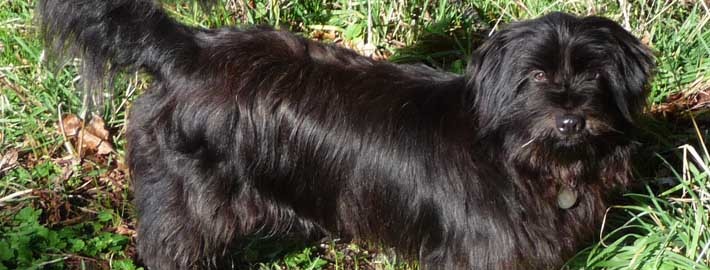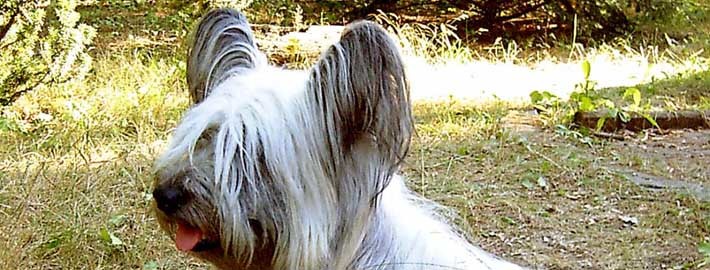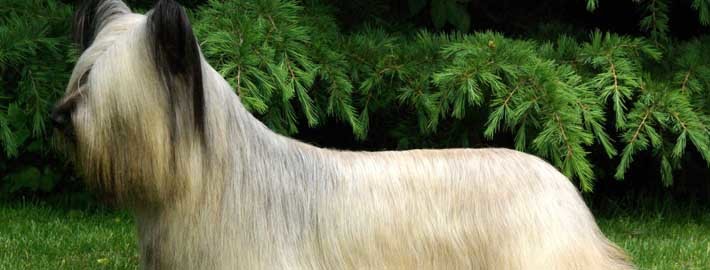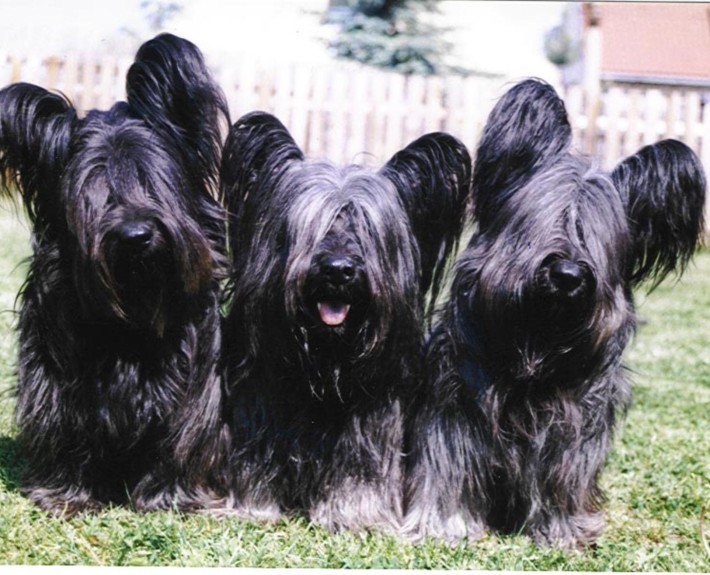What makes the Skye Terrier Unique?
The Skye terrier is a stylish and elegant dog that is, first of all, a working terrier. It is solidly built, with substantial bone, and twice as long as it is tall. The Skye’s short legs enable it to go to ground in pursuit of fox and badger, and the long back imparts flexibility within a confined space. Its strong jaws further aid it in dispatching its prey. Its movement is free and effortless. The hard outer coat and close undercoat afford protection from the teeth of its quarry as well as harsh weather. The outer coat lies straight and flat, 5½ inches or more in length. The Skye terrier’s soft look belies its tough nature. It is a fearless and a deadly rodent hunter. It is also a mild-mannered house pet, one of the few terriers calm enough to live in the city. It still needs daily exercise in a safe area or on leash, however. It is sensitive yet stubborn. The Skye is affectionate with its family but cautious with strangers. It gets along fairly well with other dogs in the same household but may not mingle well with strange dogs. It is extremely courageous and game and makes a good watchdog.
Breed Groups
Page Contents
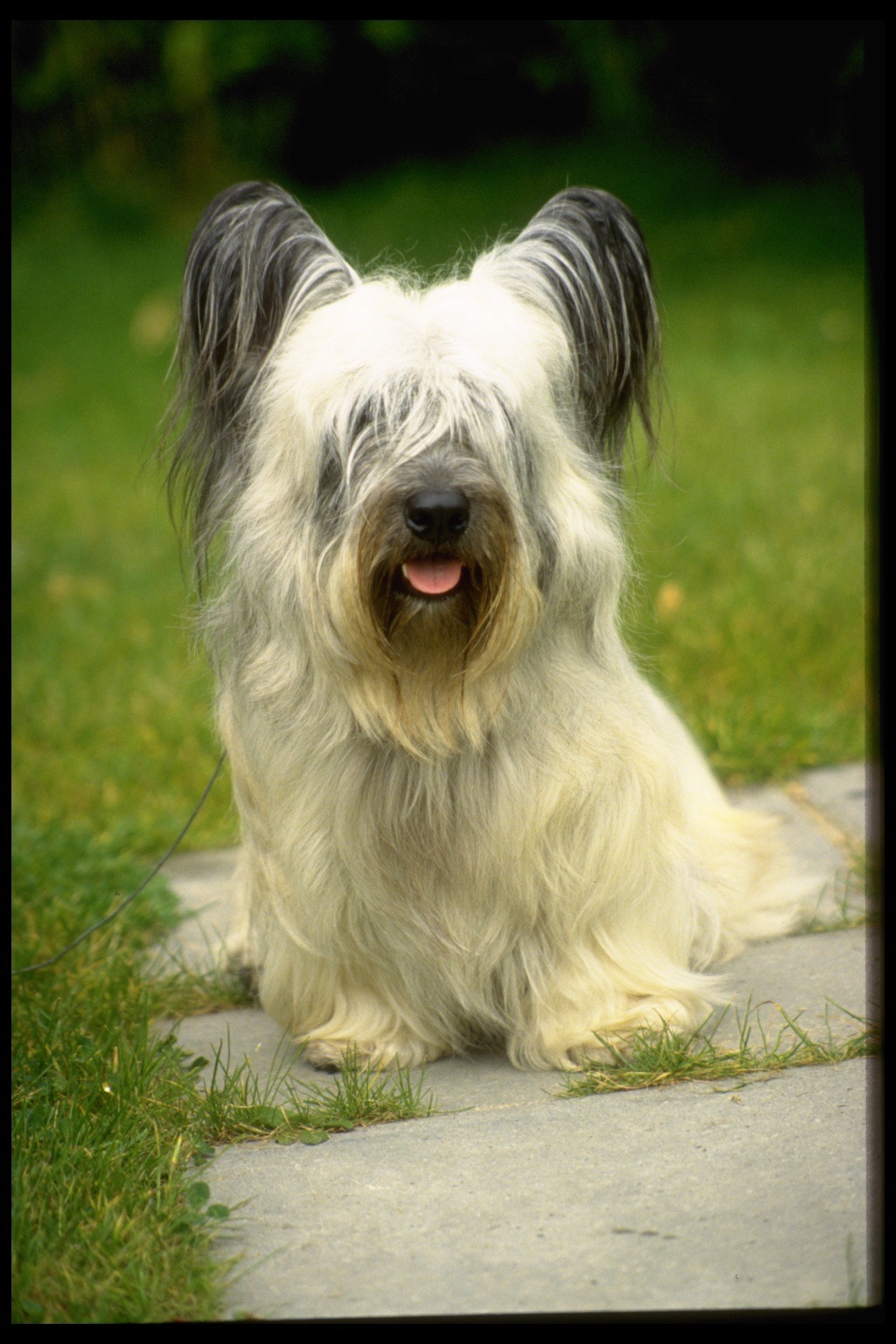
Is the Skye Terrier Right For You?
Skyes are a medium sized dog with short legs, a long body, and a large head. The coat must be brushed several times a week to avoid uncomfortable mats and trimming is necessary to keep the hair from dragging along the ground. If you are considering purchasing a Skye Terrier puppy, learn more. *Terrier Group; AKC recognized in 1887.
*Ranging in size between 35 to 45 pounds.
*Elegant, dignified, agile; vermin hunter.
In 5 Words
- Fearless
- Loyal
- Friendly
- Gay
- Intelligent
Characteristics
Learn About the Skye Terrier
Description
General Description
These stylish, medium-sized dogs are a working breed. A lengthy body, short limbs, a tapered muzzle, and a sizeable head are all feature of this breed. Skye Terriers are sturdy creatures with strong jaws enable them to swiftly dispatch vermin. They typically have black noses and dark brown eyes. A level or scissors bite is another breed standard. The ears on this breed are typically upright but, although rare, hanging ears are not unknown or against breed standards. These dogs have wide, rabbit like feet that allow them to move with a free and easy gait. Feathered pendant tails are common on members of this breed but their tail should not curl.
Size
Females of this breed stand between 8 and 9 inches (20 and 24 centimeters) high at the withers or the shoulder blades, while their male counterparts are slightly taller at 9 to 10 inches (24 to 25 centimeters) high. The male dogs are also slightly heavier as they typically weigh around 35.3 to 39.7 pounds (16 to 18 kilograms). Female Skye Terriers generally weigh between 25.4 and 30.9 pounds (11.5 and 14 kilograms)
Coat
Skye Terriers have a double coat that is comprised of a coarse outer layer measuring and a dense inner layer. The outer coat typically measures around 5.5 inches (14 centimeters) in length. This fur is generally parted in the middle. Both layers of fur are useful in protecting these dogs from both the harsh climate of their native land and the sharp teeth of their intended prey. These dogs come in a variety of solid colors including fawn, cream, platinum, grey, blue, or black. There may also be white markings present on a dog’s chest. Owners should note that it is typical for a Skye Terrier’s coat to change color as they progress from puppies to adults.
Short History of the Skye
Among the oldest of terrier breeds in its home country, the Skye Terrier has been employed as hunters of rodents and other farm yard pest for centuries. The breed’s long coat made it worthy of comment in publications dating back to the 1500s, although many different types of dogs were once known as Skye Terriers and the breed’s history difficult to trace as a result.
What is known is that Queen Victoria took a liking to these feisty little dogs in the 1840s and Skye Terriers enjoyed an increase in popularity thanks to Her Majesty’s notice. By 1887, the breed had been granted official status by the American Kennel Club and was a popular breed in shows. One of the most renowned members of this breed was Greyfriars Bobby who maintained a 14 year old vigil at his owner’s grave after the gentleman died. Despite this touching tribute and their earlier recognition by high society, these dogs eventually experienced a decline in popular leading them to be a lesser known breed.
Temperament
Although they resemble dainty house dogs and will happily live in the city, these terriers were nonetheless bred to be fierce and courageous vermin fighters. Skye Terriers can be stubborn, but are otherwise have a polite, mannerly disposition. In fact, they are quite friendly towards members of their human family and other canines living in their household. Unfamiliar animals and people can make these dogs wary. As result, Skye Terriers make good watchdogs but should be socialized early so that they remain calm under all circumstances and do not become overly protective of their human family members.
Caring for Your Skye Terrier
General Health
Born in litters of about 4 pups, the Skye Terriers generally live about 13 years. One in ten Skye Terriers will fall victim to degenerative disc disease, which is a major health concern for dogs with short limbs. However, the main cause of death for this breed is mammary cancer. Other health problems typically found this breed include hyperthyroidism, tumors, and autoimmune system problems.
Care
Daily
Skye Terriers do not require a lot of exercise and a short daily walk is best. These dogs have been known to become tired after being taken out on long excursions, so owners should avoid doing so. They will need to keep in mind that these dogs can generally get enough activity in their day by running around the house. Regular cleaning of the mouth and eye areas is also recommended to prevent either area from becoming dirty and promote good health.
Weekly
These dogs will need to be brushed a few times per week so that mats do not occur. Cleaning a dog’s teeth regularly also help encourage good health and fresh breath. Owners may also need to give their pets a trim once a week to prevent their pet’s long fur from dragging the ground, unless the terrier is outfitted with a shorter cut.
Monthly
It is generally a good idea to administer heartworm, flea, and tick prevention products to pets on a monthly basis.
Grooming & Bathing
Terriers of this breed keep their puppy coats for several years but after that need regular grooming. Long coated dogs require more frequent combing than their short haired contemporaries. Therefore, owners may opt to keep their Skye Terrier’s fur clipped short. These terriers shed moderate amounts of fur.
Exercise & Training
Skye Terriers are intelligent but, as is the case with most terrier breeds, having patience with them and being consistent in training them will go a long way in getting them to behave. These dogs greatly benefit from being socialized with unfamiliar dogs and people at young age so they are accepting of strangers in later life. Doing so also help prevents the dogs from acquiring unwanted barking or biting habits
However, owners should note that Skye Terriers can easily damage their bones if they exercise too much at a young age. Until these dogs reach about 10 months old, they should be prevented from leaping, climbing, and running around. Long walks should likewise be avoided. This lets their growth plate fully close and prevents the dogs from having either bow legs or pronounced limps.

